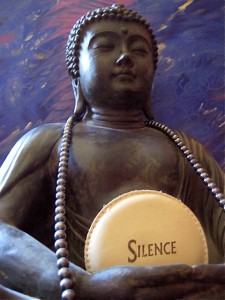
Jan and I spend a full night in dreaming with the Dalai Lama. The actual practice incorporates waking and sleeping. With each waking, a quarter turn of the body into the next quadrant of the full circle of sleeping positions is made—from side to back to side to stomach—as the night goes on. With each turn there is a return to sleep for further dream teaching, as the unfolding mandala of our dreaming progresses.
At the end of the night the Dalai Lama is dying and I anxiously ask him who will be his successor, the next Dalai Lama. Secretly, I hope it will be me!
Finally, the dying Dalai Lama turns to me and says: “My successor will be LUCKY.” And with that he dies.
Earlier that evening, Jan and I had watched an interview with the Dalai Lama conducted by Arianna Huffington on the steps of St. Paul’s Cathedral in London as he celebrated the Templeton Prize, awarded to him for his decades of focus on the connection between the investigative traditions of Buddhism and science, seeking to advance the world.
In his somewhat challenged English, the Dalai Lama talked about the reality of neuroplasticity, the scientific validation of real growth and alteration in the brain directly caused by the practices of mindfulness meditation and compassion. The brain grows by developing new regulatory circuits leading to deep, contented calm through these practices.
The Dalai Lama downplayed religion as a catalyst of change, even suggesting that religions will never agree. On the other hand, science, he said, validates that we can change ourselves, and our planet, through the practices of mindfulness meditation and compassion for all beings. Through these practices, inner peace is achievable, with the added benefit of relieving the environment of the burdens of our over-consumptive attempts to soothe ourselves by other means; using drugs, alcohol, etc., combined with our desires for material goods and comforts that, in the end, have little real meaning but greatly impact our human potential and the earth.

The Dalai Lama decided to award the 1.7 million dollar Templeton Prize to the Save the Children Foundation. He envisions a movement to teach compassion and meditation to children in school, at an early age, as a foundational way to balance young minds and change the world.
So, who is LUCKY, the next Dalai Lama?
In researching the meaning of the word “luck,” I was struck by the juxtaposition of two worlds—spiritual and scientific—in its meaning. The spiritual dimension suggests that luck is prescribed by supernatural or spiritual forces that cause fortuitous events. From a scientific perspective, luck is a random or fortuitous event that is willfully generated or logically explicable. Since spirits can’t show up for scientific method, they can exist only in science fiction, not hard science. However, the results are the same: something happens!
So, my dream Dalai Lama, as well as the living Dalai Lama, while acknowledging a spiritual dimension, lays emphasis on generating luck—LUCKY—through hard science. He points out that neuroplasticity is hard science. Neuroplasticity, with its contented neural pathways, generates GOOD LUCK! He tells us not to bother with spirituality but to instead engage in practical science: Change the brain through mindfulness meditation and compassion and bring LUCKY to life!
LUCKY is the end of a singular line of Dalai Lamas. My dream Dalai Lama tells me that we are all LUCKY if we are willing to engage in the practice of mindfulness meditation that leads to pure compassion. Compassion is first discovering the Buddha or Lucky One in the Self, then seeing the Buddha—or LUCKY—in everyone, using mindfulness-based meditation leading to compassion.

I am awestruck at how the ancient family trees of Tibetan Buddhism and Carlos Castaneda’s line of Shamanism have evolved from their homelands into Everyman’s Land. Castaneda ended his line of shamanism in its traditional format by launching the practice of Tensegrity and introducing the idea of the new Nagual in all of us. My dream indicates that the Dalai Lama’s exodus from Tibet, with Buddhism’s diaspora throughout the world, offers us all the opportunity to be the next Dalai Lama, if we follow the scientific practice to grow our brains through neuroplasticity into LUCKY, the compassionate beings we truly are. These are the offerings of the ancient roots of these traditions: we are all embodiments of Buddha, the Nagual, God.
Where these two ancient/modern traditions converge is in the practice of recapitulation, either through using the ancient magical passes or in a mindfulness meditation practice, as the present self takes the full journey to change through revisioning life lived. These evolutionary practices of change promote brain growth—neuroplasticity in action—offering the circuitry for the real experience of compassionate detachment with love. Ultimately, finding the pathway to true compassion means being able to find the Golden Buddha in even the cruelest of tyrants.
In the end, aren’t we all LUCKY?
Chuck
